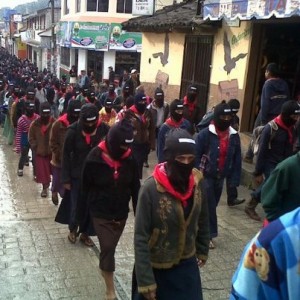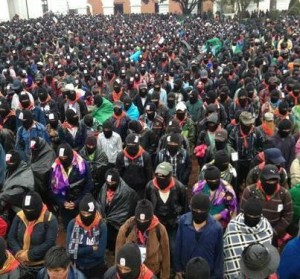 After months (years?) of people talking about Mayans in the past tense, as a bygone civilization that predicted the end of the world, tens of thousands of Zapatistas quietly filed out of the mountains in southern Mexico and flooded into the central plazas of five municipalities in the state of Chiapas. They stayed for a couple hours and then left—all of it, in total silence, left fists raised in the air. High-end estimates say as many as 40,000 people marched from Zapatista communities—indigenous choles, mam, tojolabales, tzotziles, and zeltales. They peacefully took the same plazas that the EZLN (Zapatista Army of National Liberation) seized by force almost exactly 19 years ago. La Jornada says it’s the largest mobilization by the Zapatistas since their armed uprising on New Year’s Day 1994. Amid a steady drizzle, calls of support from spectators was all that broke the silence.
After months (years?) of people talking about Mayans in the past tense, as a bygone civilization that predicted the end of the world, tens of thousands of Zapatistas quietly filed out of the mountains in southern Mexico and flooded into the central plazas of five municipalities in the state of Chiapas. They stayed for a couple hours and then left—all of it, in total silence, left fists raised in the air. High-end estimates say as many as 40,000 people marched from Zapatista communities—indigenous choles, mam, tojolabales, tzotziles, and zeltales. They peacefully took the same plazas that the EZLN (Zapatista Army of National Liberation) seized by force almost exactly 19 years ago. La Jornada says it’s the largest mobilization by the Zapatistas since their armed uprising on New Year’s Day 1994. Amid a steady drizzle, calls of support from spectators was all that broke the silence.
The display of strength came as a surprise—even for close observers of the movement. As is their way, the Zapatistas organized secretly, methodically, and carried out their action with military precision, donning their trademark ski masks and bandanas. As for reading into the action, one could point to the recent inauguration of Mexico’s new president—from the same party that ruled Mexico for 70 years. That could have something to do with it, but it’s not like the Zapatistas to be motivated from anything happening “up above” in a political and economic system they’ve long since marooned from into autonomous communities. Public political activity for the Zapatistas—like their pronouncements—come in ebbs and flows. It’s been more of an ebb the past couple years. For today, at first no word came from the EZLN or the various other committees and commissions of the movement about the action—”coming soon,” said their main portal.
 San Cristobal de las Casas, Chiapas’ capital, had a reported 20,000 Zapatistas in the plaza until about 4 pm. In Ocosingo, a smaller town, they arrived at 6:30 am and were filing out in perfect formation by 10:30 am—again, in silence, raising nothing but their left fists. Masterful political theatre. Ocosingo was one of the first places that came under rebel control in 1994. It was the height of neoliberal euphoria—the start of NAFTA and the end of history—and the Zapatistas broke that deadening silence by swarming the state’s picturesque colonial plazas. It’s worth remembering how unbelievable it all seemed at the time. Today, those same plazas were once again packed with masked rebels: women, men, and many many youth—the latter a generation raised in rebellion. Their discipline, organization, and stealth showed once again; they were being quiet in order to be heard.
San Cristobal de las Casas, Chiapas’ capital, had a reported 20,000 Zapatistas in the plaza until about 4 pm. In Ocosingo, a smaller town, they arrived at 6:30 am and were filing out in perfect formation by 10:30 am—again, in silence, raising nothing but their left fists. Masterful political theatre. Ocosingo was one of the first places that came under rebel control in 1994. It was the height of neoliberal euphoria—the start of NAFTA and the end of history—and the Zapatistas broke that deadening silence by swarming the state’s picturesque colonial plazas. It’s worth remembering how unbelievable it all seemed at the time. Today, those same plazas were once again packed with masked rebels: women, men, and many many youth—the latter a generation raised in rebellion. Their discipline, organization, and stealth showed once again; they were being quiet in order to be heard.
Later in the afternoon came a brief communiqué signed by Zapatista spokesman Subcomandante Marcos:
To Whom This Corresponds: Hear that? It’s the sound of your world crumbling; of ours re-surging. The day that was the day, was night. And night will be the day that will be the day. DEMOCRACY! LIBERTY! JUSTICE!

Pingback: Zapatistas and Territory | Territorial Masquerades